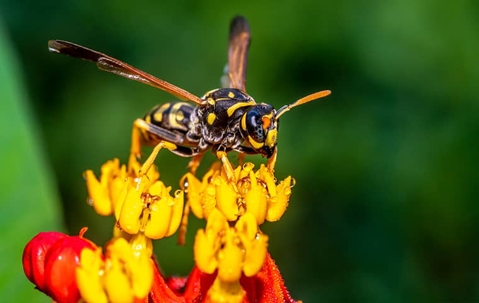Identifying Yellow Jackets
Yellow Jackets are one of the best-known wasps in Michigan, as well as the least liked. This is because yellow jackets are dangerous and are responsible for the majority of all insect stings. They inject venomous fluid under the skin. Yellow Jackets have a smooth stinger allowing them to sting as much as they want. These stings can be very painful. Between the spring and fall, we find ourselves in close contact with them because they nest in and around our homes. Another reason is that they’re attracted to many of the foods we enjoy eating outdoors.
Yellow Jackets are among the smallest of the stinging pests. A typical yellow jacket worker is about 0.5 inches (12mm) long with the queen being larger, around 0.75 inches (19mm). They are black and yellow with alternating bands on the abdomen. The yellow jacket is frequently confused with the paper wasp; they are similar in size and have black and yellow markings.
Life Cycle
Yellow Jacket colonies are annual with only inseminated queens produced in the later summer months. These new queens try and survive over the cold winter months by leaving their nest in the fall and seeking shelter in areas such as hollow longs, inside stumps, attics, and soil cavities.
Queens that survive the winter will emerge during warm days in late spring or early summer. Her next step is to select a nesting site and start building a small paper nest. She will then start to lay her eggs catering to the nest and her eggs until born. From this point on, her solo purpose is to stay in the nest and continue to lay eggs until her death in the fall. Once the first adult workers emerge, they assume all tasks of nest expansion; foraging for food, and taking care of the queen and larvae. They also begin to work on colony defense, another task we all know too well.
In mid summer, colonies rapidly grow, reaching numbers as high as 4,000 to 5,000 workers. Yellow Jackets will feed on life prey such as caterpillars and other insects. They will also forage for sugars including beer, pop, and the honeydew produced by aphids. Their mouthparts are well developed with strong mandibles for capturing and chewing insects. They also have probosces for sucking and draining nectar, fruit, and other juices they love.
Yellow jackets can forage up to around one mile from their nest. This foraging behavior brings people and yellow jackets in frequent contact, especially during the fall when numbers are at its peak and food becomes scarce. People will find them flying around at picnic tables and other areas outside where food is located. Sugars are important to new developing queens that are produced in the later summer months.
Nest
The German yellow jacket (Vespula germanica) commonly nests in wall voids, attics, crawlspaces and other enclosed cavities. The Eastern yellow jacket (Vespula maculifrons) builds their nests underground, usually in abandoned mammal burrows. Yellow jackets are social wasps, building nests that average in size between a volleyball and basketball that can contain thousands of stinging yellow jackets. Nests are made from a material called carton or paper. This material is produced by workers who combine their saliva excretions with wood fibers to form the familiar looking paper nest. A paper nest can be built by hornets, paper wasps and yellow jackets, but the yellow jacket nest is usually not visible. A yellow jacket nest resembles a hornets nest, having an opening towards the bottom. Yellow jackets and other wasps do not use the same nest year after year, but if space is available, they will build new nests in the same locations.
What Not To Do
Under no circumstances should you plug, tape, or close an area where you find yellow jackets entering and exiting structures, especially your home. This angers them, causing them to start looking for alternative routes to and from their nest, and ultimately results in them chewing their way into living quarters. Openings with yellow jackets can be sealed and caulked in November once new queens and workers have abandoned their nests.
Learn more about our home pest control and stinging insect control solutions in Port Huron.

